The weight of a motorcycle varies greatly depending on the bike type, the brand, its accessories, and more.
Motorcycle weight plays an important role in safety and performance, as well as the riding experience. For instance, lightweight bikes are easier to maneuver around tight corners, but heavier bikes are more stable.
On average, motorcycles weigh around 700 pounds.
This article will explain how motorcycle weight is calculated, what factors affect it, and what you can do to get your ideal weight. Later on, we’ll also share how much each type of bike generally weighs.
How Weight Is Calculated
Three measurements determine motorcycle weight. These are dry weight, wet weight, and the GVWR, which stands for Gross Vehicle Weight Rating.
Gross Vehicle Weight Rating
The Gross Vehicle Weight Rating (GVWR) refers to the total weight of the motorcycle, including its gear and passengers. To ensure unladen weight safety margins, the overall weight of the occupants and cargo must not exceed the GVWR.
The GVWR on touring motorcycles is crucial for their stability and handling. If it goes over the maximum weight, there will be instability, leading to accidents and injuries.
You can find the GVWR number in various spots, such as the steering neck, nearby frame, or the Vehicle Identification Number (VIN) plate. You may also check the manufacturer’s website for reference.
Dry Weight
Dry weight refers to the weight of the bike when it leaves the factory unfurled.
When comparing motorcycle dry weights, keep in mind that it is not a standardized measurement. This may be due to differences in testing techniques used by manufacturers.
Some will only exclude gas from their calculations, while others exclude fluids like brake oil, engine oil, transmission oil, etc. Therefore, you should always take this information with a grain of salt.
Wet Weight
Wet weight is the bike’s mass when it includes engine fluids like the engine oil, coolant, gas, brake oil, and battery oil. However, like dry weight, there isn’t any standardized testing process for it, so it can vary with each bike type and brand.
Factors That Affect The Weight Of A Motorcycle
The bike engine’s CC usually indicates the motorcycle size and, consequently, its weight. Still, there are other factors to consider, which will be discussed in this section.
Intended Use
Motorcycles come in many types and have different features that affect their weight. For example, off-road bikes tend to be lighter than street cruisers because they need to be agile and fast to avoid obstacles.
Similarly, dirt bikes are small, easy to maneuver, and weigh less than 300 pounds. They’re made to withstand tough conditions and handle all kinds of terrain without being hindered by their weight.
Related: Honda Grom vs. Honda Monkey
Engine Size
Motorcycles with bigger engines naturally tend to be heavier than motorcycles with smaller engines. This is because the engine is usually the heaviest part of the bike.
The engine size of most motorcycles ranges anywhere from 125cc to 1600cc. Scramblers and scooters often have smaller engines, while larger engines can be found on choppers and cruisers.
Fairings
The majority of bikes are usually equipped with plastic fairings rather than metal ones. On the other hand, older motorcycles often have metal fairings, which are heavier and add to the motorcycle’s weight.
Windscreens
Windscreens with a thicker shield help protect against snow, rain, and debris on the road. The downside is that they add to the overall weight of the bike.
Stock Luggage
Stock luggage includes the saddlebag and the panniers of the bike. Generally, touring and adventure bikes come with panniers for additional storage space. Steel panniers alone can add 10 pounds to the bike’s weight on each side.
How To Decrease Motorcycle Weight
Switching to a lighter bike will help you get more out of every horsepower and save you on gas consumption.
Lighter bikes have better acceleration, braking performance, and more responsive handling. But if changing bikes isn’t an option, here are some ways you can put your bike on a diet.
Strip Down Fairings and Windscreen
Bikes with a full-face windshield and metal fairings will weigh more than ones that use lightweight materials. You can remove some of the fairings and replace them with lighter alternatives like fiberglass and plastic. Another option is to completely remove the windscreen or use ones that are made from lighter materials.
Remove Luggage
You can remove saddlebags, backrests, tool kit boxes, and other items that add unwanted weight to the bike. Anything you carry in the panniers and saddlebags like extra fuel, helmets, and other items are added weight.
Replace Parts With Higher Quality Products
You can also look at other areas of your bike to assess if things can be replaced with something lighter. For example, a Lithium battery can be up to a quarter of the weight of a standard battery.
Similarly, you can save a lot of weight on your bike by replacing steel bolts with aluminum or titanium bolts. Moreover, hardened aluminum alloy sprockets weigh only a third of their steel counterparts.
Don’t forget the wheels are one of the heaviest parts of a bike, making up the largest proportion of unsprung weight. You can use lightweight alternatives that provide better suspension and faster steering. Generally, carbon fiber wheels weigh less and serve as a good alternative.
The Average Weight Of The Various Types Of Motorbikes
Motorcycles used for longer distances are typically lighter than those used for shorter distances. The bike’s weight can influence speed and functionality, so if you want to go faster, choose a lighter one.
In this section, we’ll discuss the average weight of each bike type so you can determine which one is most suited to your needs.
Moped
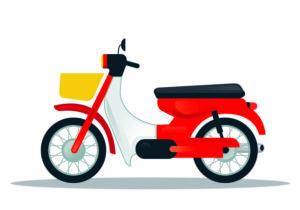
A moped is a small motorcycle that typically weighs around 150-200 pounds. They are popular in cities with large populations because of their lightweight, inexpensive build.
Scooter
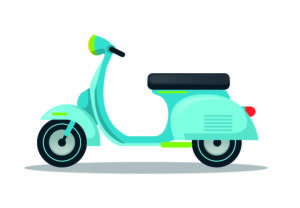
Scooters are a little heavier than mopeds. Their weight ranges from 150-300 pounds, depending on the size of their engine. Since they are quite easy to handle, they are not only great for short trips but also for long ones.
Scrambler
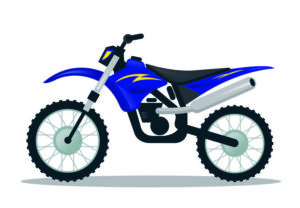
Scrambler bikes are characterized by their smaller tanks, elevated shocks, and knobby tires. They are mostly used for off-roading and can weigh between 400 to 500 pounds.
Read: What is a Scrambler?
Cruiser
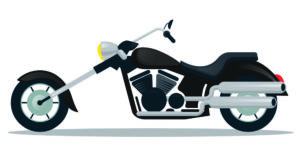
Cruise bikes are designed to be lightweight and able to travel long distances. In contrast, power cruisers are much heavier. Regular cruise bikes weigh around 300 pounds, whereas their power counterparts weigh around 500 to 600 pounds.
Sportbike
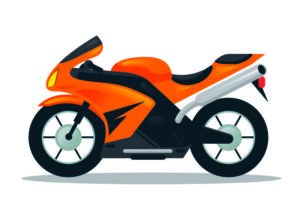
Sports bikes are designed for short distances. They usually weigh around 300-500 pounds, which is heavier than other motorcycles due to their higher performance and aerodynamic design.
Touring bike
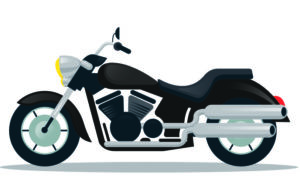
Large touring bikes, like the 2019 Honda Gold Wing, are perfect for long trips and can also be used for two-person rides. It has an 1833 cc engine and weighs about 787 pounds. You can even find touring bikes that weigh more than 1000 pounds.
Dirt bike
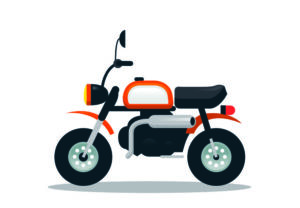
Dirt bikes are lighter than other types of motorcycles, making them easier to maneuver. The lightest dirt bikes weigh around 100-200 pounds, while the heaviest ones can weigh up to 300 pounds. They need to be light to deal with muddy and rough terrain more easily.
Adventure dirt bike
Adventure dirt bikes are significantly heavier than other dirt bikes due to the powerful engines they’re equipped with. They usually weigh around 500 pounds and can go up to 1200 cc.
Electric bike
Electric bikes come in a range of different styles and weights. On average, electric bikes usually weigh around 450 pounds. Some electric dirt bikes weigh between 200 to 350 pounds.